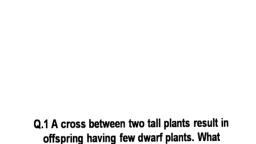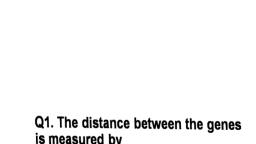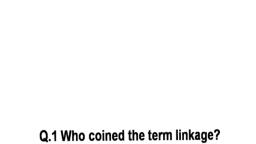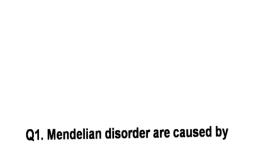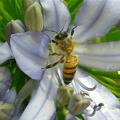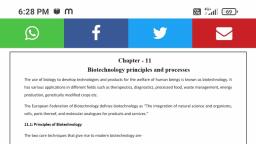Question 1 :
In the monohybrid cross Tt x tt, the phenotypic ratio of the progeny would be 
Question 2 :
The cross used to ascertain whether the plant is homozygous or heterozygous is
Question 3 :
Mendel, for his studies chose pea plants and considered many contrasting characteristics present in the pea plants. One of characteristics not considered by him was
Question 4 :
An offspring of two homozygous parents differing from one another by alleles at only one gene locus is
Question 5 :
A cross done between a homozygous recessive and a heterozygous plant is called as<br/>
Question 8 :
From a single ear of corn, a farmer planted 200 kernels which produced 140 tall and 40 dwarf plants. The genotype of these offsprings are most likely
Question 9 :
Which one of the following traits of garden pea studied by Mendel, was a recessive feature?
Question 10 :
When heterozygous red flowered plant is crossed with white flowered plant, the progeny will show ratio of
Question 11 :
Which mendelian idea is depicted by a cross in which the $F_1$generation resembles both the parents ?
Question 12 :
Which one of the following traits of garden pea, studied by Mendel, was a recessive feature?
Question 14 :
Which one of the following can not be explained on the basis of Mendel's law of dominance?
Question 16 :
A dwarf pea plant was treated with gibberellic acid (GA), it grew as tall as the homozygous tall pea plant. If this GA-treated plant is now crossed with a pure tall pea plant then the phenotypic ratio in the next generation is likely to be
Question 17 :
Heterozygote tall plant (Tt) is crossed with homozygous dwarf (tt) plant. Then what will be percentage of dwarf plants in the next generation?
Question 21 :
How many pairs of contrasting characters in pea plants were studied by Mendel in his experiments?
Question 22 :
A plant is heterozygous and is designated Bb and produces two kinds of gametes B and b. The probability of gamete B, fertilizing B or b is 
Question 23 :
Mating of an organism to double recessive for determining homozygosity or heterozygosity is called as
Question 25 :
A pure tall plant (TT) is crossed with a pure short plant (tt). The ratio of pure tall plants to pure short plants in $F_2$ generation will be
Question 27 :
Choose the correct answer from the alternatives given.<br>Considera cross in which a trait is inherited by incomplete dominance. What percentageof the F2 from the mating of homozygous dominant and homozygous recessiveindividuals will possess the dominant phenotype?
Question 28 :
Assertion: At $F_2$ stage in monohybrid cross, both parental traits are expressed in the proportion of 3:1.
Reason: The contrasting parental traits show blending at $F_2$ stage.
Question 29 :
When a cross is made between round seed and yellow seeds (RrYy) and round seed and green seeds (Rryy), what proportion of phenotype in the offspring could be expected to be wrinkled and green
Question 30 :
A cross used to ascertain whether a dominant is homozygous or heterozygous is<br/>
Question 31 :
Genes controlling seven traits in pea studied by Mendel were actually located on<br/>
Question 33 :
Which one of the following cannot be explained on the basis of Mendel's Law of Dominance _________________________.
Question 34 :
Appearance of hidden character in some progeny of $F_2$ population indicates<br>
Question 35 :
Mendel was successful in formulating the laws of inheritance whereas his predecessors were not because
Question 37 :
A tall plant was crossed with a short plant, and both tall and short offspring were produced. This is an example of<br/>
Question 38 :
In seven pairs of contrasting characters in a pea plant studied by Mendel, the number of flower based characters were
Question 40 :
The  grain colour of wheat is determine by the additive effects of two pairs of genes Accordingly the $F_2$ inhertance appears in the ratio of $15$ red ,$1$ white  the fifteen red appear in different shades in the ratio of 
Question 42 :
When a pure bred, red flower -producing plant of genotype RR is crossed with pure bred , white flowers-producingplantof genotype rr,all the ${ F }_{ 1 }$ plants produced pink flowers If all the plant in each generation from ${ F }_{ 1 }$ to${ F }_{ 6 }$ are selfed, what will be the percentage of plants with red and white flowers in the final population of plants with red and white flowers in the final population consisting of a large number of individuals? (Consider that flowers colour has no effect on reproduction and survival.)
Question 43 :
In sweet pea, genes C and P are necessary for colour in flowers. The flowers are white in the absence of either or both the genes. What will be the percentage of coloured flowers in the offspring of the cross $Ccpp \times ccPp$ ?<br>
Question 46 :
In <i>Pisum sativum</i>, the dwarfness of plant is a ________ character.
Question 48 :
The percentage of true breeding plants in the F2 generation of a monohybrid cross is ...........
Question 49 :
In a cross between individuals homozygous for (a, b) and wild type($+ +$). In this cross $700$ out of $1000$ individuals were of parental type. Then the distance between a and b is?
Question 52 :
Find the correct statements<br>(i) $F_1$ progeny is first hybrid generation and progeny resembles either of parent.<br>(ii) $F_2$progeny is a resultant hybrid generation of cross pollination among $F_1$ progeny and the progeny shows both dwarf and tall plants<br>(iii) $F_2$ progeny is second hybrid generation produced by selfing $F_1$ hybrids and progeny contains both dwarf and tall plants<br>(iv) Proportion of probability of plants that are dwarf is 1/4 of $F_2$plants while 3/4 of $F_2$plants are tall
Question 53 :
Which one of the following traits studied by Mendel in garden pea was a recessive character?
Question 55 :
How many different types of gametes can be formed by Fl progeny, resulting from the following cross:<br/>AABBCC x aabbcc<br/>
Question 56 :
<p>Mendel found that the reciprocal crosses yielded identical results. From that he concluded that     </p>
Question 57 :
In his classic experiment on pea plants, Mendel did not use ___________.
Question 58 :
If a plant is heterozygous tall and produced tall as well as dwarf in $F_2$ generation, it represents the law of
Question 59 :
In an organism, tall phenotype is dominant over recessive dwarf phenotype and the alleles are designated as T and t, respectively. Upon crossing two different individuals, total 250 offsprings were obtained, out of which 124 displayed tall phenotype and rest were dwarf. Thus, the genotype of the parents were<br/>
Question 63 :
Pure tall plants are crossed with pure dwarf plants. In the ${F}_{1}$ generation, all plants were tall. These tall plants of ${F}_{1}$ generation were selfed and the ratio of tall to dwarf plants obtained in $F_2$ was $3 : 1$. This is called as
Question 64 :
In case of taster and non-taster human beings, T is for dominance and t is for recessive gene. Which of the following would not be able to taste PTC (Phenylthiocarbamide)?


